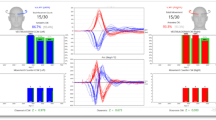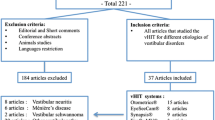Abstract
Objectives
To evaluate effects of optokinetic and rotational stimulus in individuals with and without motion sickness (MS) using fHIT.
Methods
The study included subjects aged 18–40; 35 subjects with MS for MS group and 35 subjects without vertigo for control group. Percentage of the correct answer (% CA) with and without optokinetic stimulus (o-fHIT) in the frontal plane in the fHIT test was compared in both groups. In addition, both group subjects were seated on an ordinary rotating office chair. % CA was compared between groups by applying rotational fHIT (r-fHIT) test after the subjects were rotated randomly to the right and left and also simultaneously moved their heads in the vertical plane.
Results
There was no significant difference in % CA in fHIT o-fHIT and r-fHIT in the control group. Both groups showed a significant difference in % CA for fHIT, o-fHIT, and r-fHIT for all SCCs (p < 0.05).
Conclusions
Since individuals with MS are affected by optokinetic and rotational stimuli, fHIT performed after these stimuli can be used as an objective confirming test for diagnosing MS.



Similar content being viewed by others
References
Zhang LL et al (2016) Motion sickness: current knowledge and recent advance. CNS Neurosci Ther 22:15–24. https://doi.org/10.1111/cns.12468
Turner M, Griffin MJ, Holland I (2000) Airsickness and aircraft motion during short-haul flights. Aviat Space Environ Med 71:1181–1189
Koch A et al (2018) The neurophysiology and treatment of motion sickness. Dtsch Arztebl Int 115(41):687
Golding JF (2006) Motion sickness susceptibility. Auton Neurosci 129:67–76. https://doi.org/10.1016/j.autneu.2006.07.019
Corallo G et al (2018) The functional head impulse test: preliminary data. J Neurol 265:35–39
Herdman SJ et al (1998) Computerized dynamic visual acuity test in the assessment of vestibular deficits. Am J Otol 19:790–796
Goebel JA et al (2007) Gaze stabilization test: a new clinical test of unilateral vestibular dysfunction. Otol Neurotol 28:68–73. https://doi.org/10.1097/01.mao.0000244351.42201.a7
Ramat S et al (2012) A device for the functional evaluation of the VOR in clinical settings. Front Neurol 3:39. https://doi.org/10.3389/fneur.2012.00039
Demer JL, Honrubia V, Baloh RW (1994) Dynamic visual acuity: a test for oscillopsia and vestibulo-ocular reflex function. Am J Otol 15:340–347
Versino M et al (2014) Reading while moving: the functional assessment of VOR. J Vestib Res 24:459–464
Graybiel A, Wood CD, Miller EF II (1968) Diagnostic criteria for grading the severity of acute motion sickness. Aerosp Med 39:453–455
Neupane AK, Gururaj K, Sinha SK (2018) Higher asymmetry ratio and refixation saccades in individuals with motion sickness. J Am Acad Audiol 29:175–186
Kumar RT, Sinha SK (2021) Head impulse test paradigm and suppression head impulse test paradigm in individuals with and without motion sickness. Am J Audiol 30:518–523. https://doi.org/10.1044/2021_AJA-21-00009
Kılınç FM et al (2020) Evaluation of semicircular canal functions by the Video Head Impulse Test (vHIT) in individuals with motion sickness. Evaluation 79:31–35
Fowler CG, Dallapiazza M, Hadsell KT (2020) Vestibular function and motion sickness susceptibility: videonystagmographic evidence from oculomotor and caloric tests. Am J Audiol 29:188–198. https://doi.org/10.1044/2020_AJA-19-00050
Fowler CG, Sweet A, Steffel E (2014) Effects of motion sickness severity on the vestibular-evoked myogenic potentials. J Am Acad Audiol 25:814–822
Acknowledgements
This study would not be possible without support of Erişçi Company in Turkiye that provided fHIT device. Our study was presented as an oral presentation at XXXI Bárány Society Meeting that was held in Madrid from May 9 to 11, 2022.
Funding
The authors report that no funding was obtained for the work that resulted in the article or its preparation.
Author information
Authors and Affiliations
Corresponding author
Ethics declarations
Conflict of interest
The authors declare that they have no conflicts of interest.
Additional information
Publisher's Note
Springer Nature remains neutral with regard to jurisdictional claims in published maps and institutional affiliations.
Rights and permissions
Springer Nature or its licensor (e.g. a society or other partner) holds exclusive rights to this article under a publishing agreement with the author(s) or other rightsholder(s); author self-archiving of the accepted manuscript version of this article is solely governed by the terms of such publishing agreement and applicable law.
About this article
Cite this article
Karababa, E., Satar, B. & Genç, H. Evaluation of effects of optokinetic and rotational stimuli with functional head impulse test (fHIT) in individuals with motion sickness. Eur Arch Otorhinolaryngol 280, 3149–3156 (2023). https://doi.org/10.1007/s00405-023-07819-y
Received:
Accepted:
Published:
Issue Date:
DOI: https://doi.org/10.1007/s00405-023-07819-y




